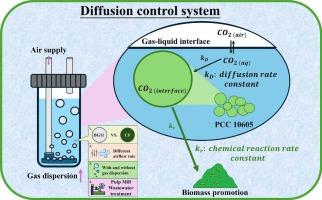Enhancing Cyanobacterium aponinum carbon uptake and metabolic flux under gas dispersion and aeration using pulp mill wastewater
IF 4.5
2区 生物学
Q1 BIOTECHNOLOGY & APPLIED MICROBIOLOGY
Algal Research-Biomass Biofuels and Bioproducts
Pub Date : 2025-10-01
DOI:10.1016/j.algal.2025.104312
引用次数: 0
Abstract
Aeration and gas dispersion critically influence the growth and carbon conversion efficiency of cyanobacterial systems, yet the direct impact on cellular metabolism remains underexplored. This knowledge gap limits the development of scalable cultivation systems optimized for carbon capture and bioproduct formation. In this study, the halophilic Cyanobacterium aponinum PCC10605 was cultured in atomizer-assisted condition at varying flow rates to evaluate the effect on biomass yield, metabolite accumulation, and CO₂ uptake dynamics. Maximum biomass productivity of 5.79 g/L was achieved at 1.5 vvm gas flowrate with atomization at day 7; where glycogen, lipid, and protein concentrations reached 3.20, 1.07, and 1.10 g/L, respectively. A comprehensive kinetic modeling incorporating reaction rate constant (kr), diffusion rate constant (kD), biomass accumulation and metabolic transformation constant (M) to explore the dominating factors in CO₂ fixation, biomass and metabolic components simultaneously. Dimensionless analysis further revealed that biomass formation was predominantly under diffusion control, with 60 % attributed to CO₂ transfer from gas to liquid phase. Finally, algae successfully increased biomass and protein amounts in a medium mixed with pulp mill wastewater under gas dispersion. These results clearly deciphered that dispersion overcomes the gas to liquid interfacial barrier, thereby offer design principles for advanced carbon capture and metabolic output through microalgal biotechnology.

利用纸浆厂废水进行气体分散曝气,提高蓝杆菌aponinum的碳吸收和代谢通量
曝气和气体分散对蓝藻系统的生长和碳转化效率有重要影响,但对细胞代谢的直接影响尚不清楚。这种知识差距限制了为碳捕获和生物产品形成而优化的可扩展栽培系统的发展。本研究以嗜盐蓝藻aponinum PCC10605为研究对象,在不同流速的雾化辅助条件下进行培养,以评估其对生物量、代谢物积累和CO 2吸收动力学的影响。在1.5 vvm气体流量雾化条件下,第7天生物量生产力达到5.79 g/L的最大值;糖原、脂质和蛋白质浓度分别达到3.20、1.07和1.10 g/L。结合反应速率常数(kr)、扩散速率常数(kD)、生物量积累和代谢转化常数(M)的综合动力学模型,同时探索CO 2固定、生物量和代谢组分的主导因素。无量纲分析进一步表明,生物质的形成主要受扩散控制,60%归因于CO₂从气相转移到液相。最后,在气体分散下,藻类成功地提高了纸浆厂废水混合介质中的生物量和蛋白质含量。这些结果清楚地解释了分散克服气液界面屏障,从而为通过微藻生物技术进行先进的碳捕获和代谢输出提供了设计原则。
本文章由计算机程序翻译,如有差异,请以英文原文为准。
求助全文
约1分钟内获得全文
求助全文
来源期刊

Algal Research-Biomass Biofuels and Bioproducts
BIOTECHNOLOGY & APPLIED MICROBIOLOGY-
CiteScore
9.40
自引率
7.80%
发文量
332
期刊介绍:
Algal Research is an international phycology journal covering all areas of emerging technologies in algae biology, biomass production, cultivation, harvesting, extraction, bioproducts, biorefinery, engineering, and econometrics. Algae is defined to include cyanobacteria, microalgae, and protists and symbionts of interest in biotechnology. The journal publishes original research and reviews for the following scope: algal biology, including but not exclusive to: phylogeny, biodiversity, molecular traits, metabolic regulation, and genetic engineering, algal cultivation, e.g. phototrophic systems, heterotrophic systems, and mixotrophic systems, algal harvesting and extraction systems, biotechnology to convert algal biomass and components into biofuels and bioproducts, e.g., nutraceuticals, pharmaceuticals, animal feed, plastics, etc. algal products and their economic assessment
 求助内容:
求助内容: 应助结果提醒方式:
应助结果提醒方式:


